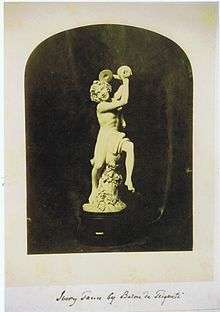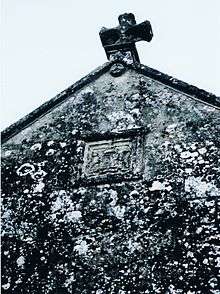Teffont Evias
Coordinates: 51°04′54″N 2°00′54″W / 51.0816°N 2.015°W
Teffont Evias, also Teffont Ewyas, past alternative spellings including Tevont Evias, is a small village and former civil parish in the south of Wiltshire, England. Edric Holmes described the village as "most delightfully situated",[1] and Maurice Hewlett included Teffont in his list of the half dozen most beautiful villages in England.[2] The present buildings are mostly of local stone, and several are thatched. With their immediate environs the older buildings are protected as a site of special building restraint.
The civil parish came to an end in 1934 and was combined with neighbouring Teffont Magna to form a united Teffont.[3]
Location
Teffont Evias lies six miles (10 km) south-west of Wilton and eight miles (13 km) from the cathedral city of Salisbury, in the valley of the River Nadder.[4]
Geology
The Purbeck Limestone underlies almost all of the parish, with a ridge of Cretaceous Upper Greensand. The Teffont Evias Quarry / Lane Cutting is protected as a geological Site of Special Scientific Interest. Fossils include some of the best Purbeck fish, with crocodile, turtle, and insect remains.[5] The Chilmark Quarries extend under Teffont and some of the disused entrances are within Teffont parish.
In the 13th century, the Teffont Evias quarries, at the southern end of the former parish, were the source of much of the freestone used in the building of Salisbury Cathedral.[6]
History
The name derives from "Teo", an old Germanic word meaning a boundary, and the Late Latin word "fontana", meaning a spring of water. The perennial stream rises at Spring Head at the north end of Teffont Magna, and flows some 2.5 km south to its debouchment into the River Nadder. Early Saxon remains have not been found to the west of the stream, and the original boundary may have separated the Romano-British from the Anglo-Saxons.[7] The "Ewyas" element derives from Ewyas Harold, the main seat of Teffont's lord at the time of Domesday Book. From Saxon times the village has been generally on the valley bottom along the course of the stream; the Teffont Archaeology Project has found remains of Roman settlement, possibly a sacred site, on higher ground.[8]

For administration, including justice, the village formed part of Dunworth Hundred; in 1502 its tithingman was presented to the hundred court for not carrying a staff as precedent required.[9]
According to Wilson's Imperial Gazetteer of England and Wales (1870–1872):
TEFFONT-EVIAS, a parish in Tisbury district, Wilts; 1¼ mile W of Dinton r. station, and 6½ W of Wilton. It has a post-office, of the name of Teffont, under Salisbury. Acres, 742. Rated property, £1,177. Pop., 163. Houses, 32. The property is all in one estate. The living is a rectory in the diocese of Salisbury. Value, £240.* Patron, W. F. De Salis, Esq. The church is good.[10]
Buildings
These are scattered along the valley of the south-flowing stream and the road, in irregular clumps giving views of the woods and fields. The manor house (listed grade II)[11] and its adjoining church date largely from the 15th century, with significant embellishments and extensions especially in the 19th century.[3] There are several workers' cottages in vernacular styles, some with carved dates in the 1600s. A few other more substantial dwellings show later work, mostly from the 19th century. The Old Rectory, built in 1842, was designed by Sir George Gilbert Scott.

The church
The Church of England parish church is called St Michael's[12] Sir Walter Raleigh mentions the church of "Tevont Evias" in his Discoverie of Guiana (1596), in connexion with the Ley family.[13] The chancel contains a notable monument in the form of three horizontal male figures, representing 16th century members of the Ley family, which owned the manor of Teffont Evias from 1545 until 1692.[6] The church's parish registers survive in the Wiltshire and Swindon History Centre for the following dates: Christenings 1684–1991, Marriages 1701–1994, burials 1683–1991.[4]
In 1914 Reverend Sir Douglas Edward Scott, 7th Baronet Scott of Great Barr, was appointed as the parish's rector. Shortly afterwards he was declared bankrupt and his rectorship terminated.[14] Four years later, he was convicted of bigamy, and imprisoned.[14]
Governance
The ancient parish of Teffont Evias formed part of the Dunworth hundred of Wiltshire.[3]
The village of Teffont Evias is now part of the parish of Teffont, which has a parish council and is in the area of the Wiltshire Council unitary authority, which is responsible for almost all significant local government functions. It forms part of the Salisbury parliamentary constituency, and the serving Member of Parliament is John Glen.
Proprietors of the Manor
In 1522 the estate was inherited by Walter Hungerford, 1st Baron Hungerford of Heytesbury; in 1540 he was attainted by act of parliament and executed for treason, sorcery, and offences forbidden by the Buggery Act 1533.[15]
The Ley family owned the manor of Teffont Evias from 1545 until 1652, when they sold it to the Ash family.[3]
%2C_Mrs_Fane_De_Salis_from_1859.jpg)
Since 1679, the estate of Teffont Evias has passed in the same local family, the Maynes (to 1907) and the Keatinges (to the present). Christopher Mayne (1655–1701), descendant of a prosperous though plebeian Exeter family, bought it in 1679 for £12,000 and moved there in 1692. The manor passed to his descendant John Thomas Mayne, FRS, FSA, (1792–1843), of the Honourable Society of the Inner Temple (2 Harcourt Buildings). A Gentleman well versed in various branches of natural knowledge, he was elected a Fellow of the Royal Society on 29 January 1818. With friends he enlarged Teffont Evias Church and gave it its present tower and steeple, and he extended and remodelled the Manor house.[3] He also improved his family tree; he included in it connections (which he could not document) to two West Country clergymen, the Catholic (now Saint) Cuthbert Mayne and the Anglican Jasper Mayne, and he spent many days researching and copying the documents of the aristocratic, extinct Mayne family of Kent, then claiming them (and some of their portraits, still in Teffont) as his own ancestors.[16]
From 1852 until her death in 1896 J. T. Mayne's eldest daughter Emily, and her husband, William Fane De Salis, were in command. They built the present service court and water tower of the Manor house. Their marriage was childless, so on Emily's death in 1896 the house and estate passed on to her next unmarried sister Margaret (d.1905), then to the youngest sister Ellen-Flora (1829–1907), Mrs. Maurice Keatinge, and thence to Ellen's eldest son Richard Keatinge. He sold it to his younger brothers Maurice Walter and Gerald Francis (1872-1965),[17] who shared the advowson of the benefice of Teffont Evias with the patrons of the church of Dinton.[18] Maurice died childless and Gerald passed the estate to his son Edgar in 1947. In 1957 the advowson was transferred to the Bishop of Salisbury.
Notable people

- Walter Hungerford, 1st Baron Hungerford of Heytesbury included Teffont Evias among his estates
- James Ley, 1st Earl of Marlborough, born at Teffont Evias ca. 1552.[20]
- Henry Ley, 2nd Earl of Marlborough, born in the Manor of Teffont Evias[21] 1595.
- William Andrew Salius Fane de Salis, married the heiress of the Mayne family and made Teffont Evias his country seat.
- Sir Edgar Keatinge (died 1998), a former politician who owned and farmed the remainder of the estate.
- Paffard Keatinge-Clay, architect and sculptor.
- Hermione Baddeley, with her husband rented the Manor and used it as a venue for boisterous parties (including mixed naked bathing in the goldfish pond).[22]
See also
References


- ↑ Wanderings in Wessex. An Exploration of the Southern Realm from Itchen to Otter https://www.gutenberg.org/files/11410/11410.txt accessed 29 March 2014
- ↑ Poorhouse to Paradise. By Lyall Ford. p3. Taipan Press, Queensland, 2001. https://books.google.co.uk/books?id=VIA17Vecpq8C&pg=PA3&lpg=PA3#v=onepage&q&f=false accessed 29 March 2014
- 1 2 3 4 5 'Parishes: Teffont Evias', in A History of the County of Wiltshire: Volume 13: South-west Wiltshire: Chalke and Dunworth hundreds (1987), pp. 185–195. Retrieved 18 March 2014.
- 1 2 Teffont Evias at genuki.org.uk. Retrieved 9 November 2010.
- ↑ Needham John E. (2011) Forests of the Dinosaurs. Wiltshire's Jurassic Finale. s.v. Teffont. ISBN 978-1-906978-01-3, Hobnob Press, East Knoyle
- 1 2 Sylvanus Urban, wd., The Gentleman's Magazine, and Historical Chronicle (1830), p. 105 online at books.google.com
- ↑ Bruce Eagles, in Roman Wiltshire and After: Papers in Honour of Ken Annable, ed. Peter Ellis. Publisher: Wiltshire Archaeological & Natural History Society. Date September 2001. ISBN 0-947723-08-0, ISBN 978-0-947723-08-8
- ↑ Teffont Archaeology Project 2012 http://www.teffont.org.uk/the-site/roman-settlement-site/ accessed 8 June 2012
- ↑ Jane Freeman and Janet H Stevenson, 'Dunworth hundred', in A History of the County of Wiltshire: Volume 13, South-West Wiltshire: Chalke and Dunworth Hundreds, ed. D A Crowley (London, 1987), pp. 89-92 http://www.british-history.ac.uk/vch/wilts/vol13/pp89-92 [accessed 27 March 2015].
- ↑ Teffont Evias at visionofbritain.org.uk
- ↑ Teffont Manor with Two Attached Follies, Teffont. British Listed Buildings. Data from English Heritage. http://www.britishlistedbuildings.co.uk/en-320397-flats-1-2-and-3-with-two-attached-follie accessed 6 January 2014
- ↑ Teffont Evias St Michael at achurchnearyou.com. Retrieved 9 November 2010.
- ↑ Joyce Lorimer, ed., Sir Walter Ralegh's Discoverie of Guiana, p. 308 online at books.google.com
- 1 2 Allen, Peter (2011-06-10). Great Barr Observer: 8. Missing or empty
|title=(help) - ↑ Parliament Roll, 31 & 32 Henry VIII, m. 42. In Harrison, William Jerome (1891). "Hungerford, Walter (1503-1540)". In Lee, Sidney. Dictionary of National Biography 28. London: Smith, Elder & Co. pp. 259–261.
- ↑ Soldiers, Saints, and Scallywags. David Gore. Wiltshire Family History Society 1997, http://issuu.com/wiltshirefhs/docs/65_-_april_1997, pp.15-18. Published by the author, 2009. https://books.google.co.uk/books?id=2_ZstVBZSfIC&lpg=PA1&pg=PA72 accessed 18 March 2014
- ↑ Audrey McBain and Lynette Nelson, The Bounding Spring (Black Horse Press, 2003, ISBN 1-904377-26-2)
- ↑ 'Teffont Magna', in A History of the County of Wiltshire, Volume 8: Warminster, Westbury and Whorwellsdown Hundreds (1965), pp. 74–78, accessed 7 July 2011.
- ↑ New Monthly Magazine, London, 1834
- ↑ Anthony Wood, Athenae Oxoniensis, vol. 2 (1692), p. 487 online
- ↑ Samuel Lewis, A topographical dictionary of England, vol. 4 (1835), p. 282
- ↑ Lesley Bates. Three-year story of village where 'much has happened'. Salisbury Journal. 4 March 2004. page 31.

.jpg)
Further reading
- A detailed history of the parish was published in 1987 by the Wiltshire Victoria County History and is available online.
- A social history of the village was published in 2003, entitled "The Bounding Spring" (Audrey McBain and Lynette Nelson. ISBN 1-904377-26-2. Black Horse Press, 2003. Summary at http://www.teffont.com/index.php/local-history)
- Elizabeth Darby, "A French Sculptor in Wiltshire: Henri de Triqueti's Panel in the Church of St Michael & All Angels, Teffont Evias", The Wiltshire Archaeological and Natural History Magazine, Vol. 95 (2002).

External links
- The village website
- Teffont Village Design Statement 2007. Approved at Wiltshire Council's Southern Area Planning Committee on 24 January 2013 as a material planning consideration. Accessed 14th November 2015.
- The Teffont Archaeology Project
![]() Media related to Teffont Evias at Wikimedia Commons
Media related to Teffont Evias at Wikimedia Commons
